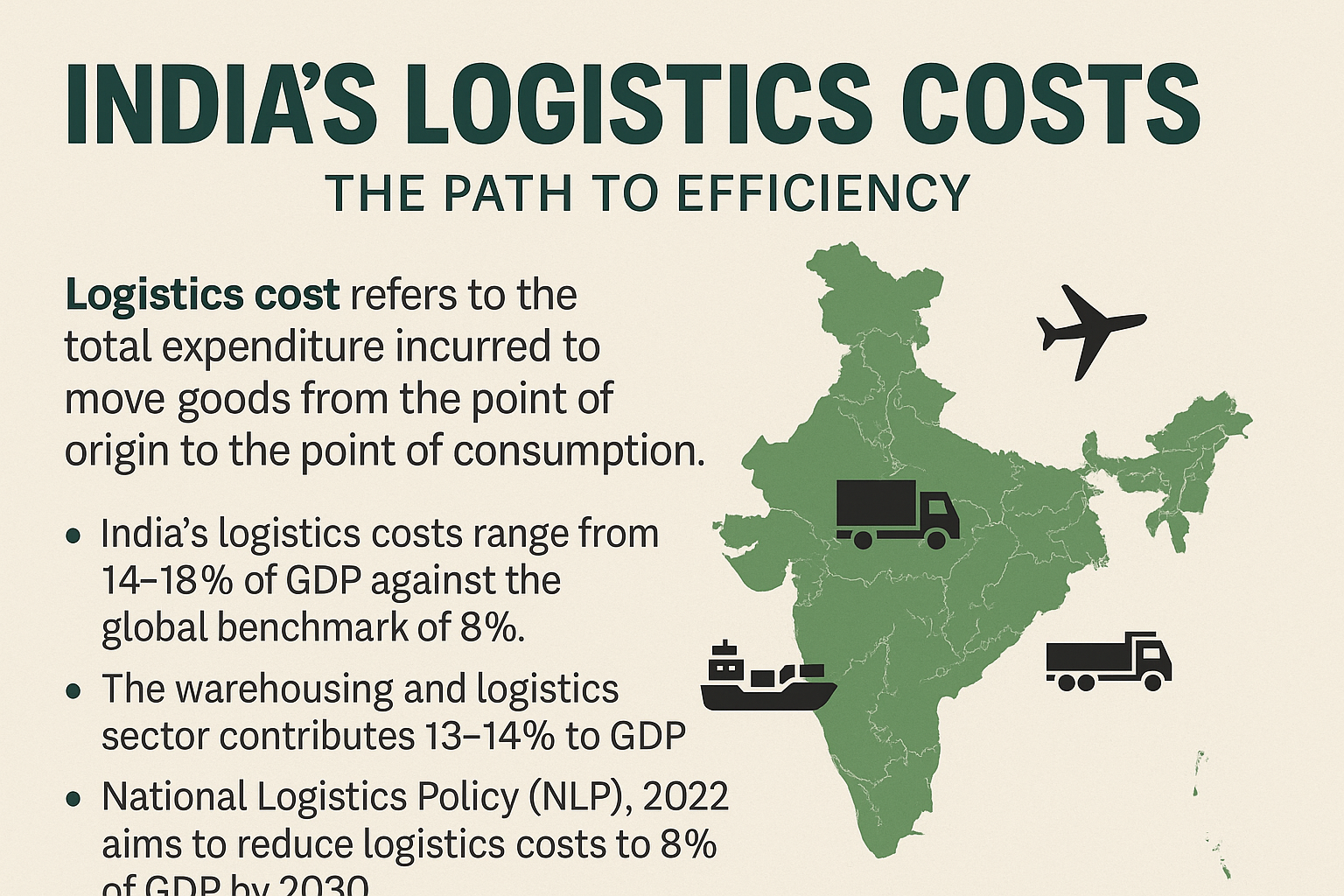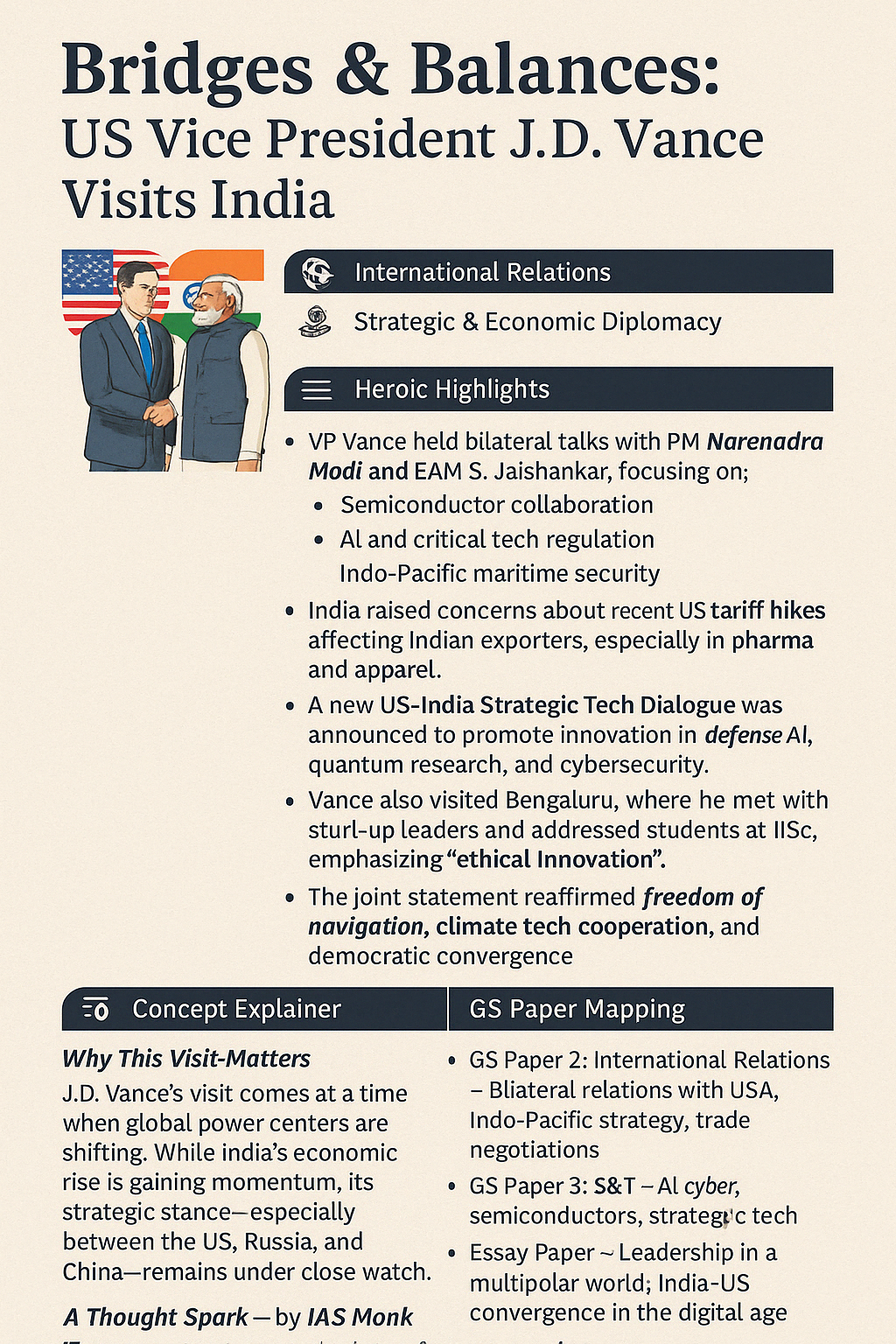
🧭June 22, 2025 Post 3: The Long Road to Speed: Why India Must Slash Its Logistics Cost Now | High Quality Mains Essay: India’s Logistics Sector: Paving the Road to Global Competitiveness | For IAS-2026 :Prelims MCQs
“The Long Road to Speed: Why India Must Slash Its Logistics Cost Now”

NATIONAL HERO — PETAL 003
🗓️ Post Date: June 22, 2025
📚 Syllabus Mapping: GS3 – Infrastructure, Economy
🎯 Thematic Focus
India’s high logistics costs — economic burden or opportunity for reform?
🌿 Intro Whisper
“Speed is the soul of modern trade — and the weight of inefficiency is a silent tax on every product we move.”
🔍 Key Highlights
- India’s logistics costs currently range from 14–18% of GDP, compared to the global benchmark of 8%.
- Union Minister has set a target to bring it down to 9% by end of 2025.
- India ranked 38th in the World Bank’s LPI (2023), showing improvement but lagging behind trade competitors.
- Major government interventions include:
- National Logistics Policy (NLP), 2022
- PM Gati Shakti National Master Plan
- Dedicated Freight Corridors, Bharatmala & Sagarmala Projects
- Core challenges persist:
- Overdependence on road transport
- Poor warehousing and low-tech adoption
- Limited modal diversity (rail/coastal underutilised)
🧭 Concept Explainer: What is Logistics Cost?
It includes all costs from product origin to end-user:
- Transportation cost
- Warehousing & inventory cost
- Packaging, admin, and compliance
These costs impact:
- Consumer prices
- Export competitiveness
- Industrial productivity
🗺️ GS Paper Mapping
- GS Paper 3 – Infrastructure: Logistics, Transportation Corridors, Sagarmala/Bharatmala
- GS Paper 3 – Economy: Manufacturing competitiveness, Ease of Doing Business
- GS Paper 2 – Governance: Policy Implementation, Inter-ministerial coordination
- Essay Paper – Infrastructure & Development Models
✨ A Thought Spark — by IAS Monk
“If India must outpace the dragon, it must first outsmart its own detours. Every delay is a tax on dreams, every roadblock a pause in destiny.”
High Quality Mains Essay For Practice :
Word Limit 1000-1200
India’s Logistics Sector: Paving the Road to Global Competitiveness
Introduction
As India aims to transform into a global manufacturing hub and economic powerhouse, the logistics sector emerges as a vital cog in this transformation. With logistics costs accounting for nearly 14–18% of India’s GDP, compared to the global benchmark of around 8%, inefficiencies in the supply chain pose a serious hurdle to growth. The recent announcement by the Union Minister for Road Transport and Highways—that logistics costs could fall to 9% by the end of 2025—signals a renewed urgency to address infrastructural, regulatory, and technological bottlenecks.
This essay delves into the past and present landscape of India’s logistics sector, key reforms such as PM Gati Shakti and the National Logistics Policy, and outlines a futuristic vision where efficient, multimodal, tech-driven logistics systems drive economic productivity, job creation, and global trade integration.
A Snapshot of the Logistics Ecosystem
Logistics encompasses all activities involved in the movement of goods from the source of production to the point of consumption. It includes transportation, warehousing, freight forwarding, inventory management, and last-mile delivery. In India, this sector contributes approximately 13–14% of GDP and employs over 22 million people, playing a central role in economic efficiency and industrial growth.
However, India’s logistics costs remain high due to fragmented supply chains, dependence on road transport, limited multimodal integration, sub-optimal warehousing, and administrative delays.
Historical Backdrop and Challenges
Historically, India’s logistics sector evolved without centralised oversight. Until recently, it remained scattered across different ministries and departments, leading to duplication of efforts and policy inconsistencies. The overdependence on roadways—handling 60% of freight—over more cost-effective railways and waterways has increased transit time and raised emissions and costs.
Some of the major challenges that have plagued the sector include:
- Lack of Integrated Infrastructure: Poor road quality, limited rail freight corridors, congested ports, and underdeveloped inland waterways have restricted seamless cargo movement.
- Inefficient Warehousing: Most warehousing facilities in India are small, unorganised, and lack automation, resulting in inventory losses and high turnaround times.
- Regulatory Bottlenecks: Complex inter-state tax regimes (prior to GST) and excessive documentation slowed down cargo clearance and border transit.
- Limited Technology Penetration: Unlike global leaders in logistics, India has seen slow adoption of digital tools like GPS tracking, AI-based route planning, or real-time supply chain monitoring.
Recent Government Reforms and Policy Push
Recognising logistics as a critical pillar for economic development, the government has undertaken significant reforms over the last few years. These include both infrastructure-based initiatives and institutional policy frameworks aimed at improving efficiency and cutting costs.
1. Granting Infrastructure Status
In 2017, logistics was granted ‘infrastructure status’, enabling easier access to long-term, low-cost credit. This move catalysed private investment in warehousing and multimodal parks.
2. PM Gati Shakti: National Master Plan
Launched in October 2021, this is a digital platform integrating 16 ministries to ensure coordinated planning and execution of infrastructure projects. It aims to reduce logistics costs by focusing on:
- Multimodal transport integration (road, rail, air, waterways)
- Efficient economic corridors
- Technology-enabled infrastructure planning
3. National Logistics Policy (NLP), 2022
The NLP marks a paradigm shift by offering a holistic roadmap for logistics development. It aims to reduce logistics cost to under 10% of GDP by 2030 by:
- Promoting Unified Logistics Interface Platform (ULIP)
- Enhancing standardisation and digital documentation
- Developing logistics skill councils and training modules
- Encouraging start-up-led innovation in last-mile delivery
4. Dedicated Freight Corridors (DFCs)
The Eastern and Western DFCs are game-changers that aim to decongest passenger rail lines and ensure faster movement of bulk goods like coal, steel, and cement.
5. Sagarmala and Bharatmala Projects
These are mega-port and highway development schemes to improve coastal shipping, port connectivity, and high-density freight corridors across the country.
6. Warehousing and PLI Support
Incentives through the Production Linked Incentive (PLI) scheme for electronics, pharmaceuticals, and food processing sectors indirectly boost demand for efficient warehousing and cold chain logistics.
India’s Logistics Potential: Comparative Perspective
India has climbed six places to 38th rank in the World Bank’s Logistics Performance Index (LPI) in 2023. However, it still lags behind countries like Germany (1st), Singapore (7th), or even regional competitors like Vietnam (ranked 34th). High logistics costs lower India’s export competitiveness and increase inflationary pressure.
With better roads, digital tracking, faster customs clearance, and port modernisation, India could match China’s efficiency, where logistics cost is just 8–9% of GDP despite being the manufacturing hub of the world.
Way Forward: Building Smart and Resilient Logistics
For India to realise its ambition of becoming a $5 trillion economy and a global export powerhouse, a transformative shift in logistics is essential.
1. Embracing Technology
- IoT and AI: Real-time fleet tracking, predictive maintenance, and AI route optimisation can significantly reduce costs.
- Blockchain: Helps build transparent, tamper-proof supply chain records.
- Digital Twins: Simulation of warehousing and transport networks to optimise delivery timelines and costs.
2. Logistics Clusters and Parks
Multimodal logistics parks being set up under the Bharatmala initiative can serve as one-stop hubs for transport, warehousing, packaging, and value-added services.
3. Green Logistics
With India’s climate targets in focus, transitioning to low-carbon logistics via electric vehicles, LNG-based trucks, and increased use of railways and inland waterways is essential.
4. Skilling and Capacity Building
Logistics is highly manpower intensive. The Logistics Skill Council (LSC) must collaborate with industry to provide job-ready training for drivers, warehouse managers, and customs agents.
5. Data and Standardisation
A central logistics database with standardised freight rates, delivery timelines, and inventory mapping will improve visibility and reduce distortions across the supply chain.
Conclusion
India’s logistics sector is undergoing a silent revolution—from an inefficient, cost-heavy legacy system to a future-ready, integrated ecosystem. With proactive policy support, rising private investments, and technology-led disruption, the country is well-positioned to reduce logistics cost to 9% or even 8% of GDP.
Such a transformation would not only boost exports and reduce inflation but also position India as a credible alternative to China in global value chains.
IAS Monk Closing Whisper:
“A nation that can move its goods swiftly, can move its destiny with purpose. For when roads and rivers unite under wisdom, prosperity travels faster than time.”
Target IAS-26: Daily MCQs :
📌 Prelims Practice MCQs
Topic: India’s Logistics Cost
MCQ 1 – Type 1: How many of the above statements are correct?
Q. Consider the following statements regarding India’s logistics sector:
1. India’s logistics cost is currently less than 10% of GDP.
2. Logistics has been granted infrastructure status in India.
3. India ranked in the top 20 in the World Bank’s Logistics Performance Index 2023.
4. The logistics sector contributes over 13% to India’s GDP.
How many of the above statements are correct?
A) Only one
B) Only two
C) Only three
D) All four
🌀 Didn’t get it? Click here (▸) for the Correct Answer & Explanation
✅ Correct Answer: B) Only two
🧠 Explanation:
1. ❌ False – India’s logistics cost is around 13–14%, not yet below 10%.
2. ✅ True – The logistics sector has been granted infrastructure status, enabling better access to finance.
3. ❌ False – India ranked 38th in the 2023 World Bank LPI, not in the top 20.
4. ✅ True – It contributes approximately 13–14% to India’s GDP.
MCQ 2 – Type 2: Two Statements Based
Q. Consider the following two statements about India’s National Logistics Policy (NLP):
1. It was launched in 2022 with the aim of reducing logistics costs to 8% of GDP by 2030.
2. The NLP focuses only on infrastructure creation and does not address digital integration.
Which of the above statements is/are correct?
A) Only 1 is correct
B) Only 2 is correct
C) Both are correct
D) Neither is correct
🌀 Didn’t get it? Click here (▸) for the Correct Answer & Explanation
✅ Correct Answer: A) Only 1 is correct
🧠 Explanation:
1) ✅ True – NLP was launched in 2022 with the goal of reducing logistics costs to 8% of GDP by 2030.
2) ❌ False – NLP strongly emphasizes digital platforms, such as ULIP, for integration and efficiency.
MCQ 3 – Type 3: Which of the statements is/are correct?
Q. Which of the following initiatives aim to improve India’s logistics infrastructure?
1. Bharatmala Pariyojana
2. Sagarmala Project
3. PM Gati Shakti
4. UDAAN Scheme
Select the correct code:
A) 1, 2 and 3 only
B) 2, 3 and 4 only
C) 1 and 4 only
D) All four
🌀 Didn’t get it? Click here (▸) for the Correct Answer & Explanation
✅ Correct Answer: A) 1, 2 and 3 only
🧠 Explanation:
1) ✅ Bharatmala focuses on highway and freight corridor development.
2) ✅ Sagarmala aims for port-led development.
3) ✅ PM Gati Shakti is an integrated infrastructure master plan.
4) ❌ UDAAN is related to regional air connectivity, not logistics.
MCQ 4 – Type 4: Direct Fact
Q. Which one of the following best defines the Dedicated Freight Corridors (DFCs) in India?
A) Exclusive high-speed railway lines for transporting passengers between metros
B) Electrified highways built for cargo trucks with overhead power
C) Specialized railway lines for freight trains, aimed at reducing transit time and decongesting passenger routes
D) High-capacity coastal shipping routes connecting Indian ports
🌀 Didn’t get it? Click here (▸) for the Correct Answer & Explanation.
✅ Correct Answer: C) Specialized railway lines for freight trains, aimed at reducing transit time and decongesting passenger routes
🧠 Explanation:
• DFCs are specialised railway corridors constructed solely for freight movement, helping decongest existing railway lines and improving cargo speed and efficiency.


















